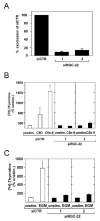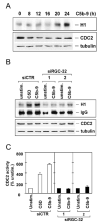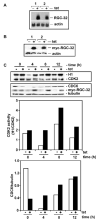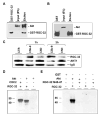Response gene to complement 32 is required for C5b-9 induced cell cycle activation in endothelial cells
- PMID: 19162005
- PMCID: PMC2699899
- DOI: 10.1016/j.yexmp.2008.12.005
Response gene to complement 32 is required for C5b-9 induced cell cycle activation in endothelial cells
Abstract
Proliferation of vascular endothelial cells (EC) and smooth muscle cells (SMC) is a critical event in angiogenesis and atherosclerosis. We previously showed that the C5b-9 assembly during complement activation induces cell cycle in human aortic EC (AEC) and SMC. C5b-9 can induce the expression of Response Gene to Complement (RGC)-32 and over expression of this gene leads to cell cycle activation. Therefore, the present study was carried out to test the requirement of endogenous RGC-32 for the cell cycle activation induced by C5b-9 by knocking-down its expression using siRNA. We identified two RGC-32 siRNAs that can markedly reduce the expression of RGC-32 mRNA in AEC. RGC-32 silencing in these cells abolished DNA synthesis induced by C5b-9 and serum growth factors, indicating the requirement of RGC-32 activity for S-phase entry. RGC-32 siRNA knockdown also significantly reduced the C5b-9 induced CDC2 activation and Akt phosphorylation. CDC2 does not play a role in G1/S transition in HeLa cells stably overexpressing RGC-32. RGC-32 was found to physically associate with Akt and was phosphorylated by Akt in vitro. Mutation of RGC-32 protein at Ser 45 and Ser 47 prevented Akt mediated phosphorylation. In addition, RGC-32 was found to regulate the release of growth factors from AEC. All these data together suggest that cell cycle induction by C5b-9 in AEC is RGC-32 dependent and this is in part through regulation of Akt and growth factor release.
Figures







Similar articles
-
RGC-32' dual role in smooth muscle cells and atherogenesis.Clin Immunol. 2022 May;238:109020. doi: 10.1016/j.clim.2022.109020. Epub 2022 Apr 22. Clin Immunol. 2022. PMID: 35462050
-
RGC-32 is expressed in the human atherosclerotic arterial wall: Role in C5b-9-induced cell proliferation and migration.Exp Mol Pathol. 2016 Oct;101(2):221-230. doi: 10.1016/j.yexmp.2016.09.004. Epub 2016 Sep 13. Exp Mol Pathol. 2016. PMID: 27619159
-
Membrane attack by complement: the assembly and biology of terminal complement complexes.Immunol Res. 2011 Oct;51(1):45-60. doi: 10.1007/s12026-011-8239-5. Immunol Res. 2011. PMID: 21850539 Free PMC article. Review.
-
Role of C5b-9 and RGC-32 in Cancer.Front Immunol. 2019 May 9;10:1054. doi: 10.3389/fimmu.2019.01054. eCollection 2019. Front Immunol. 2019. PMID: 31156630 Free PMC article. Review.
-
C5b-9-induced endothelial cell proliferation and migration are dependent on Akt inactivation of forkhead transcription factor FOXO1.J Biol Chem. 2006 Jul 14;281(28):19009-18. doi: 10.1074/jbc.M602055200. Epub 2006 May 2. J Biol Chem. 2006. PMID: 16670089
Cited by
-
Response gene to complement 32 deficiency causes impaired placental angiogenesis in mice.Cardiovasc Res. 2013 Sep 1;99(4):632-9. doi: 10.1093/cvr/cvt121. Epub 2013 May 21. Cardiovasc Res. 2013. PMID: 23695833 Free PMC article.
-
RGC-32 Regulates Generation of Reactive Astrocytes in Experimental Autoimmune Encephalomyelitis.Front Immunol. 2021 Jan 25;11:608294. doi: 10.3389/fimmu.2020.608294. eCollection 2020. Front Immunol. 2021. PMID: 33569054 Free PMC article.
-
Anlotinib Downregulates RGC32 Which Provoked by Bevacizumab.Front Oncol. 2022 May 18;12:875888. doi: 10.3389/fonc.2022.875888. eCollection 2022. Front Oncol. 2022. PMID: 35664796 Free PMC article.
-
Sublytic C5b-9 triggers glomerular mesangial cell apoptosis via XAF1 gene activation mediated by p300-dependent IRF-1 acetylation.Cell Death Dis. 2014 Apr 17;5(4):e1176. doi: 10.1038/cddis.2014.153. Cell Death Dis. 2014. PMID: 24743731 Free PMC article.
-
Identification of Signature Genes of Dilated Cardiomyopathy Using Integrated Bioinformatics Analysis.Int J Mol Sci. 2023 Apr 16;24(8):7339. doi: 10.3390/ijms24087339. Int J Mol Sci. 2023. PMID: 37108502 Free PMC article.
References
-
- Badea T, Niculescu F, Soane L, Fosbrink M, Sorana H, Rus V, Shin ML, Rus H. RGC-32 increases p34CDC2 kinase activity and entry of aortic smooth muscle cells into S-phase. J Biol Chem. 2002;277:502–8. - PubMed
-
- Badea TC, Niculescu FI, Soane L, Shin ML, Rus H. Molecular cloning and characterization of RGC-32, a novel gene induced by complement activation in oligodendrocytes. J Biol Chem. 1998;273:26977–81. - PubMed
-
- Bazzoni G, Dejana E. Endothelial cell-to-cell junctions: Molecular organization and role in vascular homeostasis. Physiol Rev. 2004;84:869–901. - PubMed
-
- Carney DF, Koski CL, Shin ML. Elimination of terminal complement intermediates from the plasma membrane of nucleated cells: the rate of disappearance differs for cells carrying C5b-7 or C5b-8 or a mixture of C5b-8 with a limited number of C5b-9. J Immunol. 1985;134:1804–9. - PubMed
Publication types
MeSH terms
Substances
Grants and funding
LinkOut - more resources
Full Text Sources
Other Literature Sources
Molecular Biology Databases
Miscellaneous

